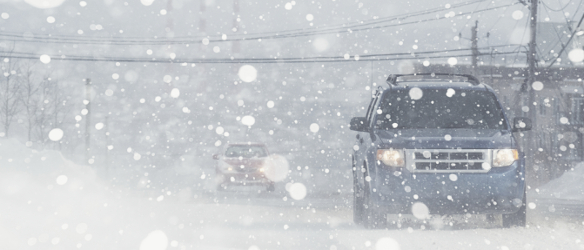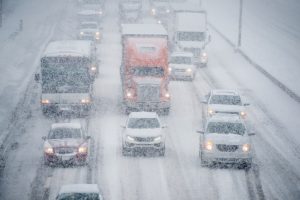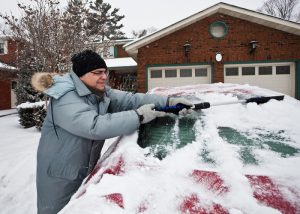
Winter Holiday Driving Tips
The winter season is an exciting time of year. A lot of us travel to see friends and family. Maybe we’re lucky enough to break-up the winter blues with a vacation at a ski lodge, or a get-away to a balmy beach locale. This is a heavily traveled time of year, but road conditions are not always great.
Wintertime can be especially harsh on vehicles, roads, and the drivers who use them. Pavement erosion, inclement weather, poor visibility and unprepared vehicles and drivers can make winter commuting dangerous and unpredictable.
Are you ready for being out on the road during winter? Taking a few moments to prepare and protect your family against winter driving dangers is essential and could spare you from potential disaster. You can help ensure you and your family members are safe in the snow this season by taking a few simple precautions now.
Keep an Emergency Kit in Your Car

You never know what can happen in the snow after you leave the house. To be on the safe side, it’s important for all drivers to be prepared for unforeseen circumstances this time of year.
Pack an emergency bag with the following items in each vehicle and you’ll be better prepared if you happen to find yourself stranded in poor weather conditions:
Vehicle Emergency Bag
- Snacks and water for at least a day
- Warm snow clothing and gloves in case you need to exit the vehicle
- Car phone charger and spare change for emergency phone calls
- Ice scraper or knocker
- Small shovel
- Flashlight and flares
- First aid kit
- Sand or kitty litter for tire traction if struck
Winter Driver's Pre Trip Inspection Checklist

Nothing derails a holiday trip like breaking down on the side of the road. No matter how reliable your car has been, it’s a good idea to check out your vehicle before heading out for the holidays.
Inspect Your Vehicle's Fluids
Change your motor oil to one that has thinner viscosity to keep your car engine operating properly when the temperatures drop below freezing.
Check Rubber Hoses and Belts
Routinely inspect vehicle hoses and belts for drying and wear and tear caused by temperature extremes, and replace when necessary.
Put On A Set Of Winter Tires
Install winter driving tires that are specially made for gripping the road and maintaining traction while driving. Use tire chains when roads are slick or snowy. Each time the temperature drops 10 degrees, tire pressure is reduced by approximately one pound per square inch, so check that your tires are properly inflated.
Check Battery Connections
Check all vehicle battery cables, connections, and ensure fluid levels are up to par.
Before Driving Warm Your Vehicle Up
Let your vehicle warm up for no more than 30 seconds after you start it in an open area, not in a garage or enclosed space.
Check Your Windshield Wipers
Keep windshield wipers and defoggers in good condition, and keep a snow brush, ice scraper, and gloves accessible. Use a windshield washer that won’t freeze.
Clear Snow And Ice Build Up
Clear ice and snow from car windows, hood and roof before driving.
10 Tips To Stay Safe On The Road When Winter Comes
- Be aware of others around you and how they are handling the road and weather conditions.
- Avoid pedal-to-the-metal take-offs or slamming on the brakes to avoid losing traction.
- Travel on main routes whenever possible, which are usually cleared, sanded and patrolled first.
- Avoid traveling during rush hours by exercising "flextime" at work.
- Avoid driving in the blind spot of other motorists on the road.
- Check weather conditions from your smartphone or use mobile apps like Waze for regular weather reports on road conditions before getting behind the wheel.
- When driving use a passenger to check the map to avoid distracted driving.
- Assume road conditions are worse than they are and allow additional travel time.
- If visibility turns bad, it’s best to pull over and wait it out. Sadly, massive, winter pileups are not uncommon.
Just last year, a ‘white out” storm caused a massive pileup on I-91 involving 20 cars, three semi-trucks, and one tanker truck.
- Know when not to drive. When weather is extreme, your life and the lives of others could be at stake. Reconsider your priorities, and if you can – stay off the roads altogether.
Have You Been in a Winter Accident in Connecticut?
If you or someone in your family is in a bad weather accident in Connecticut, contact the experienced vehicle collision attorneys at The Flood Law Firm (860) 346-2695 or (860) 346-2695. We provide a free, no-obligation consultation and will help determine whether you should file a case.
